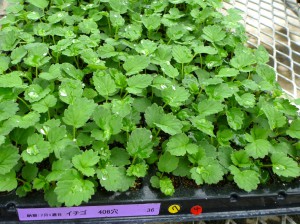
A photo provided by Mie Prefecture Agricultural Research Institute shows a new strawberry variety Yotsuboshi which can be propagated by seeds.

Young Yotsuboshi plants grown in plastic cell trays are seen in a photo provided by Mie Prefecture Agricultural Research Institute.
Mie, Kagawa, Chiba prefectures and National Agriculture and Food Research Organization’s Kyushu Okinawa Agricultural Research Center announced Wednesday, July 23, that they have jointly developed a new strawberry variety which is propagated by seed.
Yotsuboshi, whose application for registration was made open on July 14, has the potential to grow vast numbers of good-quality plants with higher efficiency compared with the common propagation method of growing plants by runners, as plant offspring hardly inherits viral diseases from parent plants. Moreover, since it is a F1 hybrid, the first filial generation of offspring of distinctly different parental types, growers do not have to worry about the plants proliferated without permission.The new variety, which was named Yotsuboshi (four stars) because of its high-quality combination of sweetness, sourness, flavor and taste, is the nation’s second variety propagated by seed, after Chiba F-1 developed by Chiba Prefecture.
A F1 hybrid imported from abroad is Elan F1, a summer-bearing variety developed in the Netherlands, which is used in cakes.
Yotsuboshi can be cultivated in major producing areas nationwide as out-of-season crops using artificial heat. It is red, shiny and cone-shaped, with high sugar content and acidity and rich flavor. The sugar content of the liquid extracted from defrosting a whole fruit of frozen Yotsuboshi strawberry was 10.6 degrees Brix, but the measurement for cortex, or the main flesh, rose to 13 degrees.
Mie Prefecture Agricultural Research Institute officials say Yotsuboshi tastes better than existing varieties propagated by seeds, as its sugar content is higher than 9 degrees for Elan F1 and 9.8 degrees for Chiba F-1. It compares favorably in terms of taste with major high-sugar-content varieties propagated by runners, according to the institute.
Because it is an everbearing variety, it is regarded suitable for cultivation as a summer-bearing fruit in Hokkaido and the Tohoku region, as well as for strawberry forcing in warm areas in the Kyushu and Shikoku regions.
The four institutes began development of the variety in 2009 by crossbreeding a mother plant grown in Mie and a father plant grown in Kagawa. They plan to start supply and sales of Yotsuboshi in 2016, considering that it is expected to take two to three years for the new variety to be registered. For the time being, they said they will work on developing a planting technology which will maximize the merits of the new variety.
“We believe growers will take an interest in the new variety and its good taste,” said an official of the Mie institute. “Maybe in two to three decades, varieties propagated by seeds will become the mainstay (of strawberry farming).”
(July 24, 2014)

